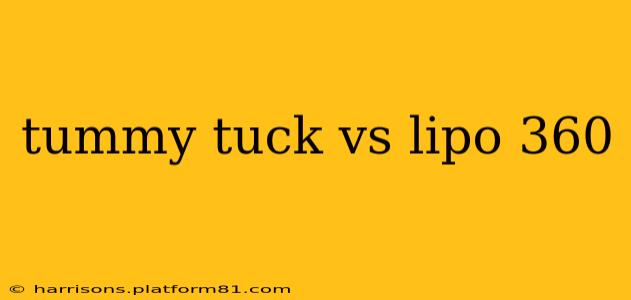Choosing between a tummy tuck (abdominoplasty) and a 360-lipo is a significant decision requiring careful consideration of your body goals, lifestyle, and overall health. Both procedures aim to improve body contouring, but they achieve this through different methods and address different concerns. This comprehensive guide will help you understand the key differences to make an informed choice.
What is a Tummy Tuck (Abdominoplasty)?
A tummy tuck is a surgical procedure that removes excess skin and fat from the abdomen, tightens the abdominal muscles, and reshapes the abdominal wall. It's ideal for individuals who have significant loose skin, excess fat, and weakened abdominal muscles, often resulting from pregnancy, significant weight loss, or aging. The procedure can dramatically improve the appearance of the abdomen, creating a flatter, firmer stomach.
What are the benefits of a tummy tuck?
- Significant skin and fat removal: Addresses excess skin and fat that doesn't respond to diet and exercise.
- Muscle tightening: Strengthens and tightens abdominal muscles, resulting in a more toned appearance.
- Improved body contour: Creates a smoother, more defined abdominal profile.
- Increased self-confidence: The improved body image can significantly boost self-esteem.
What are the risks and recovery time associated with a tummy tuck?
Tummy tucks are major surgical procedures with potential risks including infection, bleeding, scarring, and blood clots. Recovery time is typically several weeks, requiring significant downtime and adherence to post-operative instructions.
What is 360 Lipo?
360-lipo, or 360-degree liposuction, is a body contouring procedure that removes fat from multiple areas of the body, typically including the abdomen, flanks (love handles), back, and sometimes the inner and outer thighs. Unlike a tummy tuck, it doesn't tighten muscles or remove excess skin. It's best suited for individuals with localized fat deposits but relatively firm skin.
What are the benefits of 360 Lipo?
- Fat removal from multiple areas: Targets fat deposits in various areas simultaneously.
- Improved body shape: Creates a more sculpted and defined physique.
- Less invasive than a tummy tuck: Generally involves a shorter recovery period and less downtime.
What are the risks and recovery time associated with 360 Lipo?
While less invasive than a tummy tuck, 360-lipo still carries risks, including bruising, swelling, infection, and uneven fat removal. Recovery time is generally shorter than a tummy tuck, but individuals can expect some discomfort and limitations for several weeks.
Tummy Tuck vs. Lipo 360: Which is Right for Me?
The choice between a tummy tuck and 360-lipo depends on your individual needs and goals.
- Choose a tummy tuck if: You have significant excess skin and fat, weakened abdominal muscles, and desire significant abdominal reshaping.
- Choose 360-lipo if: You have localized fat deposits, relatively firm skin, and want to improve body contouring in multiple areas with minimal downtime.
Can I Combine Tummy Tuck and Lipo 360?
Yes, it's possible to combine a tummy tuck with 360-lipo for optimal results. This combined approach addresses both excess skin and fat, achieving a more dramatic body transformation. However, it also increases the complexity of the procedure, extending recovery time and potential risks.
What is the cost of a tummy tuck and 360 lipo?
The cost of both procedures varies depending on the extent of the procedure, the surgeon's fees, and the geographic location. It's crucial to consult with a board-certified plastic surgeon to get a personalized cost estimate.
What are the long-term results of a tummy tuck and 360 lipo?
With proper post-operative care and maintenance of a healthy lifestyle, the results of both procedures can be long-lasting. However, significant weight fluctuations can impact the longevity of the results.
Are there any non-surgical alternatives?
Yes, there are non-surgical alternatives like CoolSculpting and Emsculpt, which can help reduce fat and tone muscles. However, these procedures are less effective for significant skin laxity or muscle weakness. Consult with a qualified practitioner to determine if these options are suitable for you.
Remember to consult a board-certified plastic surgeon for a thorough evaluation and personalized recommendation. They can assess your individual needs and help you determine the best approach to achieve your desired body contouring goals.
